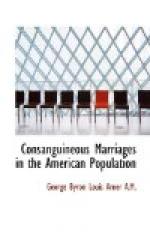In 1871 and 1881 the inquiry was more minute and the degrees of consanguinity were specified. Mr. Huth quotes some of the figures for these years, probably derived from the same sources as Table XXVI, and comments as follows: “An examination of this table will show that the statistics so much relied upon as proving the causation of deaf-mutism by consanguineous marriages show nothing of the sort. In 1871 fourth cousins produced more deaf-mutes per marriage than any nearer relationship. In 1881 third cousins produced more than any nearer relationship."[83] Mr. Huth forgets that he is basing these statements on five and nine families respectively, and does not take into consideration the probability that if the returns are biased, as he suspects, this bias would affect the more distantly related, relatively more than the first cousin marriages, for the same reason that this would be true of the cases collected by Dr. Bemiss.[84] Combining the figures of the two censal years helps to correct these averages, and the distantly related show approximately the same average as the first cousin marriages in spite of the vastly greater selection which must have obtained in the distantly related cases.
[Footnote 83: Huth, Marriage of Near Kin, p. 227.]
[Footnote 84: Cf. supra, p. 42.]
In Table XXVI it will be seen that 52.5 per cent of the deaf-mute offspring of consanguineous parents were the offspring of first cousin marriages. On the assumption that this percentage is fairly typical of each set of returns we may say that from three to six per cent of the Irish deaf-mutes are the offspring of first cousin marriages. If, then, the proportion of first cousin marriages is no greater than in England, the percentage of deaf-mute offspring is several times as great as in the average non-related marriage.
TABLE XXVI. ------------------------------------------------------------
-------------- | 1871 | 1881 | 1871 and 1881 |-----------------------------------------------------------
| |Number| | |Number| | |Number| | | of |Aver | | of |Aver | | of |Aver |Number|conge-|age |Number|conge-|age |Number|conge-|age Consanguinity | of |nital |per | of |nital |per | of |nital |per of |mar- |deaf- |mar- |mar- |deaf- |mar- |mar- |deaf- |mar- Parents. |riages|mutes |riage|riages|mutes |riage|riages|mutes |riage ------------------------------------------------------------
-------------- First cousins | 72 | 128 | 1.78| 74 | 123 | 1.66| 146 | 251 | 1.72 Second cousins| 50 | 89 | 1.78| 29 | 46 | 1.58| 79 | 135 | 1.71 Third cousins | 24 | 40 | 1.67| 9 | 21 | 2.33| 33 | 61 | 1.85 Fourth cousins| 5 | 11 | 2.20| 1 | 1 | — | 6 | 12 | 2.00 Fifth and | | | | | | | | | sixth cousins | 12 | 19 | 1.58| not stated | 12 | 19 | 1.58




